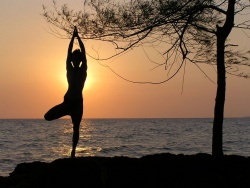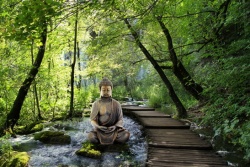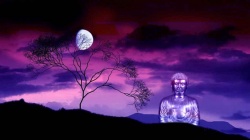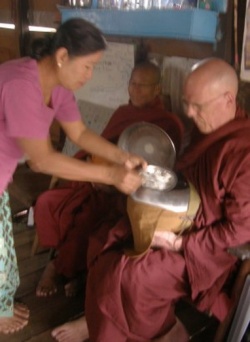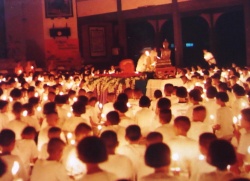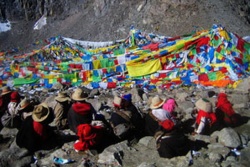Kailash
Click here to see other articles relating to word Kailash
Mount Kailash (also Mount Kailas ; (Tibetan : གངས་རིན་པོ་ཆེ, Kangrinboqê or Gang Rinpoche ; simplified Chinese : 冈仁波齐峰, Gāngrénbōqí fēng) is a peak in the Kailas Range (Gangdisê Mountains), which are part of the Transhimalaya in Tibet .
It lies near the source of some of the longest rivers in Asia: the Indus River , the Sutlej River (a major tributary of the Indus River ), the Brahmaputra River , and the Karnali River (a tributary of the Ganges River ).
It is considered a sacred place in four religions : Bön, Buddhism , Hinduism and Jainism . The mountain lies near Lake Manasarowar and Lake Rakshastal in Tibet .
Nomenclature, orthography and etymology
The mountain is known as Kailāsa (कैलास) in Sanskrit . The word may be derived[citation needed] from the word kēlāsa (केलास) which means "crystal".
In his Tibetan -English dictionary, Chandra (1902: p. 32) identifies the entry for 'kai la sha' (Tibetan : Wylie: kai la sha) which is a loan word from Sanskrit 'kailāsa' (Devanagari: कैलास).
The Tibetan name for the mountain is Gangs Rin-po-che. Gangs or Kang is the Tibetan word for snow peak analogous to alp or himal; rinpoche is an honorific meaning "precious one" so the combined term can be translated "precious jewel of snows".
ka i la sha - Mt. Kailash. See {ri bo gangs can} [RY]
ke la sha - the mount Kailash. Mt. Kailash. See {gangs ti se}. See {ri bo gangs can} [RY]
gangs dkar ti si - Mt. Kailash, Gang Tisey Mountains [RY]
gangs dkar ti se - The White Snow Mountain, Kangkar Tisey, Mt. Kailash (lit. Silver Mountain), is one of the world's great holy mountains, sacred to Hindus and Buddhists alike. It is one of the so-called "Three Holy Places of Tibet,"
associated with the body, speech, and mind aspects of Chakrasamvara and Vajra Varahi. The other two are Lapchi (la phyi) and Tsari (tsa ri).
These three are also listed among the "twenty-four sacred places" (Skt. pitha) of the world, Kailash being identified as Himavat, Labchi as Godavari, and Tsari as both Caritra and Devikota.
There are several descriptions of and guides to Mt. Kailash, including one written by Könchok Tendzin Chökyi Lodrö, the sixth Drigung Chungtsang ('bri gung chung tshang dkon mchog bstan 'dzin chos kyi blo gros, 1829-1906), and a recent one composed originally by Chöying Dorje, which came to light in (1990). (MR) (RY)
chu bo bzhi - 1) the Four Great Rivers flowing in the four directions from Mt. Kailash: Brahmaputra, Ganges, Yamuna, Indus. 2) Four Currents or, four pools are: {'dod pa} or, desire. {srid pa} or, existence. {ma rig pa} or, ignorance. {log par lta ba} or, - wrong views. (RY)
ti se' gangs - Mt. Kailash. (RY)
stod gangs ri - Mt. Kailash. (RY)
Please expand with additional information regarding Mt. Kailash here.
Discussion
The following is from Matthieu Ricard (MR) in his The Life of Shabkar.
The terms you may have been searching for will appear bolded in this wonderfully educational, and highly abbreviated geographic description of how the land of Tibet actually lives through it's cultural habitat, both historically and spiritually:
from chapter 11, pgs. 342-343, note 10:
The White Snow Mountain, Kangkar Tise (gangs dkar ti se), Mt. Kailash (literally 'Silver Mountain'), is one of the world's great holy mountains, sacred to Hindus and Buddhists alike.
It is one of the so-called "Three Holy Places of Tibet", associated with the body, speech, and mind aspects of Chakrasamvara and Vajravarahi.
The other two are Lapchi (la phyi) and Tsari (tsa ri).
These three are also listed among the "Twenty-four Great Sacred Places" (Tib. - gnas chen nyer gzhi), (Skt. - pitha) of the world, Mt. Kailash being identified as Himavat, Lapchi as Godhavari, and Tsari as both Caritra and Devikota.
There are several descriptions of and guides to Mt. Kailash, including one written by Konchog Tendzin Chokyi Lodro, the sixth Drigung Chungtsang ('bri gung chung tshang dkon mchog bstan 'dzin chos kyi blo gros, 1829-1906), and a recent one originally composed by Choying Dorje which came to light in (1990), hereafter quoted as MK.
It is recounted in the Chakrasamvara Tantra and it's commentaries (as related in MK) that the world was once ruled by Bhairava, the wrathful form of Mahadeva, who made the land of Magadha the seat of his power.
It is said also that four devas and four gandharvas descended from the sky and established their dominion in the eight places known as the Eight Celestial Abodes (mkha' spyod kyi gnas brgyad).
Likewise, four yakshas and four rakshasas, already on the earth, made their way to Jambudvipa, where they established themselves in the Eight Earthly Abodes (sa spyod kyi gnas brgyad, while four [[naga]s and four asuras came to Jambudvipa from beneath the earth, to settle themselves in Eight Underground Abodes (sa 'og gi gnas brgyad).
They invited Bhairava to visit their dwellings, twenty-four in all, but he, instead of coming personally, manifested in each place as a lingam to which these savage beings would make blood sacrifices.
These demonic forces prevailed from the "golden age" until the beginning of our present "era of strife and conflict." It was then, the tantra recounts, that the Blessed One, Vajradhara, knew that the time had come to subdue these unsuitable beings.
Without his mind ever wavering from objectless compassion (dmigs pa med pa'i snying rje), he arose in the formidable wrathful display of a Heruka with four heads and twelve arms.
He danced, and through the power of the nondual wisdom of all the Buddhas, trampled down Mahadeva and his consort together with their retinue, liberating their minds into the absolute expanse and establishing them in great bliss.
The Heruka then blessed each of the twenty-four abodes as a palace of Chakrasamvara and each of the twenty-four lingams as a mandala of sixty-two wisdom deities.
The sixty-two are Chakrasamvara and his consort, and his retinue: the twenty-four male and twenty-four female Bodhisattvas, and the twelve goddesses.
At the nirmanakaya level, it is said that Mt. Kailash was miraculously blessed by Buddha Shakyamuni and five hundred arhats. Once, Ravana (mgon po beng) and his consort had taken to their palace in Lanka one of the three statues of Buddha Shakyamuni which the Lord himself had blessed.
Desiring to place this statue on a worthy support, Ravana had planned to take Mt. Kailash on his back and carry it to Lanka.
At the same moment Lord Buddha and five hundred arhats came flying through the sky and alighted to the west of Mt. Kailash, leaving their footprints in the rock.
The Buddha stepped on all four sides of the mountain, leaving footprints in the rock which are known as the Four Immutable Nails of Kailash (mi 'gyur ba'i gzer bzhi).
Ravana thus was unable to lift the mountain.
Then the Buddha sat on a rock in front of the mountain and taught Dharma to the naga king Anavatapta, the lord of the Lake Manasarovar.
He then taught the Lankavatara Sutra to Ravana, and blessed him and his consort as the Glorious Wisdom Protector, the Great Being and Consort (dpal ye shes mgon po beng chen lcam dral).
Mt. Kailash was later blessed by Guru Padmasambhava, and became famous after Jetsun Milarepa lived there and held his contest of miracles with Naro Bonchung.
(When Jetsun Milarepa and the Bonpo Naro Bonchung held their famous contest of miracles to decide who would retain supremacy over the sacred mountain, they left imprints of their feet in the rocks and many other miraculous signs.
See G. C. C. Chang, (1962, vol. 1, pp. 215-224).
Later Gyalwa Gotsangpa (rgod tshang pa mgon po rdo rje), Linge Repa (gling rje ras pa) (1128-1188), and many other great meditators lived ascetic lives at the foot of Mt. Kailash.
In particular, holders of the Drigung Kagyu lineage frequented this place in great numbers.
Drigung Jigten Gonpo ('bri gung 'jigs rten mgon po 1143-1217) had a dream in which the guardian deities of the Three Sacred Places of Tsari, Lapchi, and Kailash came and prostrated themselves before him, requesting him to go and bless their territories.
Jigten Gonpo replied that he would send great meditators instead. Accordingly, he dispatched 80 hermits to each place.
Some years later, he reputedly sent 900 hermits and finally 55,525 practitioners to each site (see Huber, 1989). At Kailash these were under the leadership of the great pandita Yakgangpa (pan chen yag sgang pa), who is also called (according to MK, pg. 59),
Dorzin Guhya Gangpa (rdor 'dzin gu hya sgang pa); at Lapchi the practitioners were led by Geshe Paldrak (dge bshes dpal grags, 12th-13th century); and at Tsari they were under the guidance of Dorzin Gowoche (rdor 'dzin mgo bo che).
In the Three Sacred Places of Tsari, Lapchi, and Kailash, Dorzin (rdor 'dzin = Holder of the Vajra) usually refers to a spiritual master or an administrator sent from Drigung Monastery as representative of the Drigung hierarchs. (see Petech 1978, 317.) (MR-ShabkarNotes).
- "Tibetan Buddhists call it Kangri Rinpoche ; 'Precious Snow Mountain'.
Bon texts have many names: Water's Flower , Mountain of Sea Water, Nine Stacked Swastika Mountain. For Hindus , it is the home of the mountain god Shiva and a symbol of his power symbol om;
for Jains it is where their first leader was enlightened ; for Buddhists , the navel of the universe ; and for adherents of Bon , the abode of the sky goddess Sipaimen."
Another local name for the mountain is Tisé (Tibetan : ) mountain, which derives from ti tse in the Zhang-Zhung language , meaning "water peak" or "river peak",
connoting the mountain's status as the source of the mythical Lion , Horse, Peacock and Elephant Rivers , and in fact the Indus, Yarlung Tsangpo/Dihang/Brahmaputra, Karnali and Sutlej all begin in the Kailash -Lake Manasarovar region.
Religious significance
In Hinduism
According to Hinduism , Lord Shiva , the destroyer of ignorance and illusion , resides at the summit of a legendary mountain named Kailāsa, where he sits in a state of perpetual meditation along with his wife Pārvatī.
According to Charles Allen, one description in the Vishnu Purana of the mountain states that its four faces are made of crystal, ruby, gold, and lapis lazuli .
It is a pillar of the world and is located at the heart of six mountain ranges symbolizing a lotus .
The ancient Koneswaram temple of Trincomalee is heralded as "Dakshina Kailasam"/"Then Kailasam" (Kailash of the South) because it lies on exactly the same longitude as Mount Kailash and due to its pre-eminence in Saivite belief.
Koneswaram's early black granite rock-cut architectural style shared similarities to famous Kailasanathar Temples of the subcontinent,
named after the mountain peak. Koneswaram's traditional history and legends were compiled into the Tamil corpus Tevaram and the Sanskrit treatises Dakshina Kailasa Puranam — Sthala Puranam of Koneswaram,
written in 1380 by Jeyaveera Cinkaiariyan, and the Dakshina Kailasa Manmiam — three chapters of the Skanda Puranam of unknown antiquity — manuscripts of which have been discovered and dated from the 5th — 7th century.
Many of the Kailasanathar temple 's sculptures and relics depict episodes relating to Lord Shiva and Maa Parvati, including Ravana's tale. (Ravana was a devotee of Lord Shiva .
Ramayana does not document Ravana shaking the mountain.) Ravana's mother had fallen ill.
As they were great Lord Shiva devotees, he had attempted to carry the temple on his back to bring it closer to his mother. Shiva , being stunned by his boldness,
had blessed him with immortality as Ravana had passed Lord Shiva 's test of devotion.
In Jainism
In Jainism , Kailash is also known as Meru Parvat or Sumeru . Ashtapada, the mountain next to Mt.Kailash is the site where the first Jain Tirthankara , Rishabhadeva, attained Nirvana /moksa (liberation ).
(The authenticity of Mount Kailash being Mount Ashtapada is highly debated.)
In Buddhism
Tantric Buddhists believe that Mount Kailash is the home of the Buddha Demchok (also known as Demchog or Chakrasamvara), who represents supreme bliss .
There are numerous sites in the region associated with Guru Rinpoche (Padmasambhava ), whose tantric practices in holy sites around Tibet are credited with finally establishing Buddhism as the main religion of the country in the 7th–8th century CE.
It is said that Milarepa (c. 1052-c. 1135 CE), champion of Tantric Buddhism , arrived in Tibet to challenge Naro Bön-chung, champion of the Bön religion of Tibet .
The two magicians engaged in a terrifying sorcerers' battle, but neither was able to gain a decisive advantage. Finally, it was agreed that whoever could reach the summit of Kailash most rapidly would be the victor.
While Naro Bön-chung sat on a magic drum and soared up the slope, Milarepa's followers were dumbfounded to see him sitting still and meditating .
Yet when Naro Bön-chung was nearly at the top, Milarepa suddenly moved into action and overtook him by riding on the rays of the sun, thus winning the contest.
He did, however, fling a handful of snow on to the top of a nearby mountain, since known as Bönri, bequeathing it to the Bönpo and thereby ensuring continued Bönpo connections with the region
In Bön
The Bön, a religion which predates Buddhism in Tibet, maintain that the entire mystical region and the nine-story Swastika Mountain are the seat of all spiritual power .
Pilgrimage
Every year, thousands make a pilgrimage to Kailash , following a tradition going back thousands of years. Pilgrims of several religions believe that circumambulating Mount Kailash on foot is a holy ritual that will bring good fortune .
The peregrination is made in a clockwise direction by Hindus and Buddhists .
Followers of the Jain and Bönpo religions circumambulate the mountain in a counterclockwise direction. The path around Mount Kailash is 52 km (32 mi) long.
Some pilgrims believe that the entire walk around Kailash should be made in a single day, which is not considered an easy task. A person in good shape walking fast would take perhaps 15 hours to complete the 52 km trek.
Some of the devout do accomplish this feat, little daunted by the uneven terrain, altitude sickness and harsh conditions faced in the process.
Indeed, other pilgrims venture a much more demanding regimen, performing body -length prostrations over the entire length of the circumambulation:
The pilgrim bends down, kneels, prostrates full-length, makes a mark with his fingers, rises to his knees, prays, and then crawls forward on hands and knees to the mark made by his/her fingers before repeating the process.
It requires at least four weeks of physical endurance to perform the circumambulation while following this regimen.
The mountain is located in a particularly remote and inhospitable area of the Tibetan Himalayas .
A few modern amenities, such as benches, resting places and refreshment kiosks, exist to aid the pilgrims in their devotions.
According to all religions that revere the mountain, setting foot on its slopes is a dire sin .
It is claimed that many people who ventured to defy the taboo have died in the process[citation needed]. It is a popular belief that the stairways on Mount Kailash lead to heaven.
Following the political and border disturbances across the Chinese -Indian boundary, pilgrimage to the legendary abode of Lord Shiva was stopped from 1954 to 1978.
Thereafter, a limited number of Indian pilgrims have been allowed to visit the place, under the supervision of the Chinese and Indian governments either by a lengthy and hazardous trek over the Himalayan terrain,
travel by land from Kathmandu or from Lhasa where flights from Kathmandu are available to Lhasa and thereafter travel over the great Tibetan plateau by car.
The journey takes four night stops, finally arriving at Darchen at elevation of 4,600 m (15,100 ft), small outpost that swells with pilgrims at certain times of year.
Despite its minimal infrastructure, modest guest houses are available for foreign pilgrims , whereas Tibetan pilgrims generally sleep in their own tents.
A small regional medical center serving far-western Tibet and funded by the Swiss Ngari Korsum Foundation was built here in 1997.
Walking around the holy mountain—a part of its official park—has to be done on foot, pony or yak, taking some three days of trekking starting from a height of around 15,000 ft (4,600 m) past the Tarboche (flagpole) to cross the Drölma pass 18,200 ft (5,500 m), and encamping for two nights en route.
First, near the meadow of Dirapuk gompa, some 2 to 3 km (1.2 to 1.9 mi) before the pass and second, after crossing the pass and going downhill as far as possible (viewing Gauri Kund in the distance).
Mountaineering
Although Mount Kailash has never been climbed, a number of mountaineers have prospected the mountain with a view to climbing it.
In 1926, Hugh Ruttledge studied the north face, which he estimated was 6,000 ft (1,800 m) high and "utterly unclimbable" and thought about an ascent of the north-east ridge, but he ran out of time .
Ruttledge had been exploring the area with Colonel R. C. Wilson, who was on the other side of the mountain with his Sherpa named Satan.
According to Wilson, Satan told Wilson, "'Sahib, we can climb that!' ... as he too saw that this [the SE ridge] represented a feasible route to the summit."
Further excerpts from Wilson's article in the Alpine Journal (vol. 40, 1928) show that he was utterly serious in his intention to climb Kailash , but, as with Ruttledge, he ran out of time .
Herbert Tichy was in the area in 1936, attempting to climb Gurla Mandhata. When he asked one of the Garpons of Ngari whether Kailash was climbable, the Garpon replied, "Only a man entirely free of sin could climb Kailas .
And he wouldn't have to actually scale the sheer walls of ice to do it – he'd just turn himself into a bird and fly to the summit."
Reinhold Messner was given the opportunity by the Chinese government to climb the mountain in the 1980s but he declined. In 2001 the Chinese gave permission for a Spanish team led by Jesus Martinez Novas to climb the peak, but in the face of international disapproval the Chinese decided to ban all attempts to climb the mountain.
Messner, referring to the Spanish plans, said, "If we conquer this mountain, then we conquer something in people's souls ... I would suggest they go and climb something a little harder. Kailas is not so high and not so hard.



